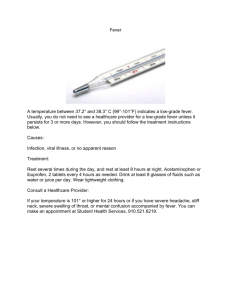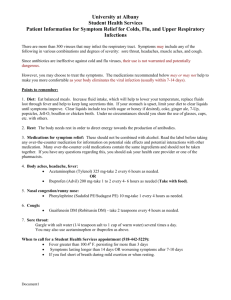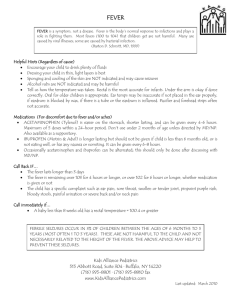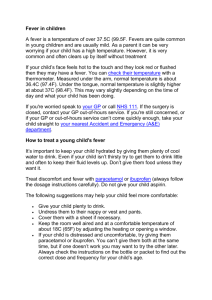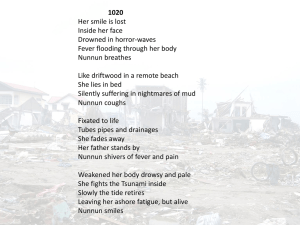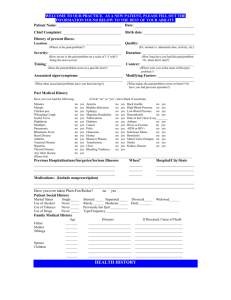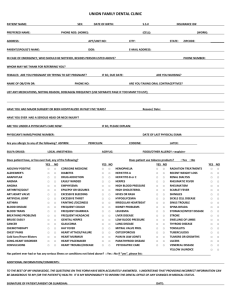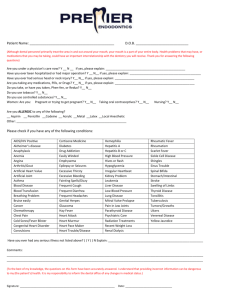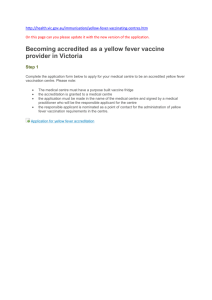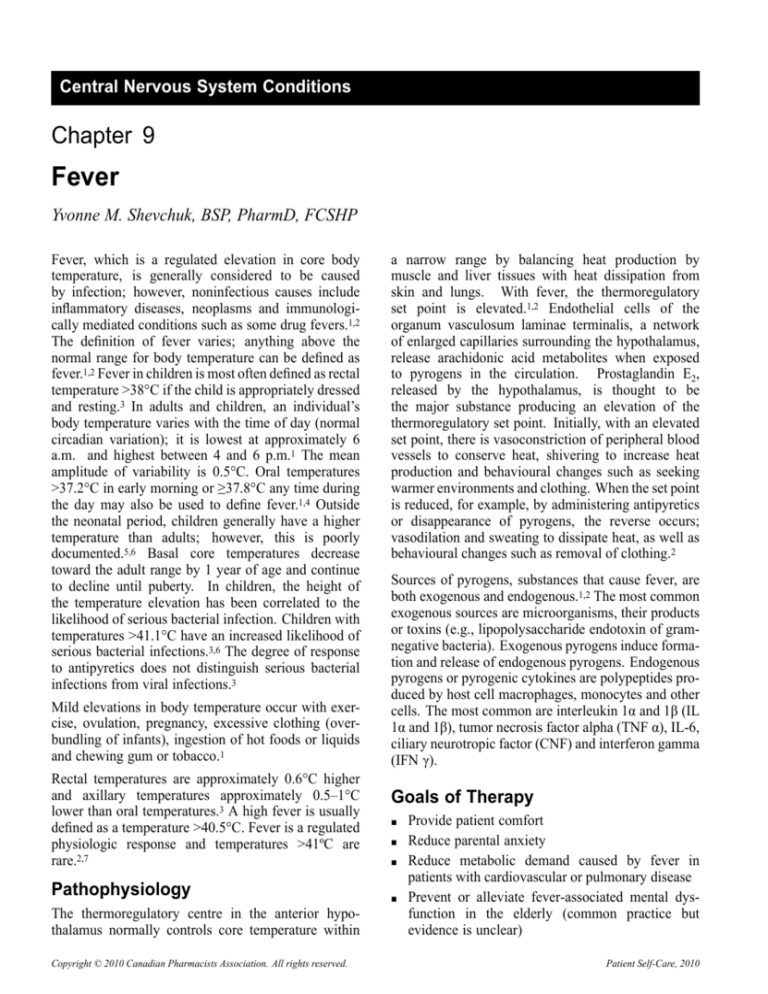
Central Nervous System Conditions
Chapter 9
Fever
Yvonne M. Shevchuk, BSP, PharmD, FCSHP
Fever, which is a regulated elevation in core body
temperature, is generally considered to be caused
by infection; however, noninfectious causes include
inflammatory diseases, neoplasms and immunologically mediated conditions such as some drug fevers.1,2
The definition of fever varies; anything above the
normal range for body temperature can be defined as
fever.1,2 Fever in children is most often defined as rectal
temperature >38°C if the child is appropriately dressed
and resting.3 In adults and children, an individual’s
body temperature varies with the time of day (normal
circadian variation); it is lowest at approximately 6
a.m. and highest between 4 and 6 p.m.1 The mean
amplitude of variability is 0.5°C. Oral temperatures
>37.2°C in early morning or ≥37.8°C any time during
the day may also be used to define fever.1,4 Outside
the neonatal period, children generally have a higher
temperature than adults; however, this is poorly
documented.5,6 Basal core temperatures decrease
toward the adult range by 1 year of age and continue
to decline until puberty. In children, the height of
the temperature elevation has been correlated to the
likelihood of serious bacterial infection. Children with
temperatures >41.1°C have an increased likelihood of
serious bacterial infections.3,6 The degree of response
to antipyretics does not distinguish serious bacterial
infections from viral infections.3
Mild elevations in body temperature occur with exercise, ovulation, pregnancy, excessive clothing (overbundling of infants), ingestion of hot foods or liquids
and chewing gum or tobacco.1
Rectal temperatures are approximately 0.6°C higher
and axillary temperatures approximately 0.5–1°C
lower than oral temperatures.3 A high fever is usually
defined as a temperature >40.5°C. Fever is a regulated
physiologic response and temperatures >41ºC are
rare.2,7
Pathophysiology
The thermoregulatory centre in the anterior hypothalamus normally controls core temperature within
Copyright © 2010 Canadian Pharmacists Association. All rights reserved.
a narrow range by balancing heat production by
muscle and liver tissues with heat dissipation from
skin and lungs. With fever, the thermoregulatory
set point is elevated.1,2 Endothelial cells of the
organum vasculosum laminae terminalis, a network
of enlarged capillaries surrounding the hypothalamus,
release arachidonic acid metabolites when exposed
to pyrogens in the circulation. Prostaglandin E2,
released by the hypothalamus, is thought to be
the major substance producing an elevation of the
thermoregulatory set point. Initially, with an elevated
set point, there is vasoconstriction of peripheral blood
vessels to conserve heat, shivering to increase heat
production and behavioural changes such as seeking
warmer environments and clothing. When the set point
is reduced, for example, by administering antipyretics
or disappearance of pyrogens, the reverse occurs;
vasodilation and sweating to dissipate heat, as well as
behavioural changes such as removal of clothing.2
Sources of pyrogens, substances that cause fever, are
both exogenous and endogenous.1,2 The most common
exogenous sources are microorganisms, their products
or toxins (e.g., lipopolysaccharide endotoxin of gramnegative bacteria). Exogenous pyrogens induce formation and release of endogenous pyrogens. Endogenous
pyrogens or pyrogenic cytokines are polypeptides produced by host cell macrophages, monocytes and other
cells. The most common are interleukin 1α and 1β (IL
1α and 1β), tumor necrosis factor alpha (TNF α), IL-6,
ciliary neurotropic factor (CNF) and interferon gamma
(IFN γ).
Goals of Therapy
■
■
■
■
Provide patient comfort
Reduce parental anxiety
Reduce metabolic demand caused by fever in
patients with cardiovascular or pulmonary disease
Prevent or alleviate fever-associated mental dysfunction in the elderly (common practice but
evidence is unclear)
Patient Self-Care, 2010
Chapter 9: Fever
Patient Assessment (Figure 1)
Fever is a symptom or sign of illness, not a disease,
and the reason for fever should be determined.3 Most
commonly it is due to infection, often viral. Fever persisting longer than 3 days in those >6 months, recurrent
fever or high fever (>40.5°C) should be evaluated by a
physician.
Once fever is established, the body initiates processes
to permit homeostasis. Peripheral vasodilation causes
the skin to feel hot. Sweating may occur. Malaise and
fatigue may be seen at higher temperatures. Headache,
81
backache, myalgia, arthralgia, somnolence, chills and
rigors may also be associated with fever.
Drug-induced fever is a symptom of hypersensitivity
but can occur with other symptoms such as myalgia,
chills and headache. Table 1 lists several medications
associated with drug-induced fever.9,10,11
Fever differs from hyperthermia, which is an increase
in core temperature without an increase in hypothalamic set point. If hyperthermia is suspected, refer the
patient to a physician; antipyretics are not useful (see
Chapter 10, Heat-related Disorders).
Figure 1: Assessment of Patients with Fever1,3,6,8
Patient Self-Care, 2010
Copyright © 2010 Canadian Pharmacists Association. All rights reserved.
82
Central Nervous System Conditions
Table 1:
Selected Drugs Associated with
Fever9,10,11
Allopurinol
Amphotericin Ba
Antacids
Antibacterials/
antibiotics (e.g.,
cephalosporins,
penicillins,
SMX/TMP)
Anticholinergics
Antihistamines
Antineoplastics
(e.g., cisplatin,
hydroxyureaa)
Atropine
Azathioprinea
Barbiturates
Carbamazepine
Clofibrate
Corticosteroids
Cyclosporine
Digoxin
Diltiazem
Doxepin
Epinephrine
Folic acid
Furosemide
Griseofulvin
Heparin
Hydralazine
Hydrochlorothiazide
H2-receptor
antagonists (e.g.,
cimetidine)
Insulin
Interferon
Iodides
Isoniazid
Iron dextran
Metoclopramide
Methyldopaa
MAOIs
Mycophenolate
NSAIDs (e.g.,
ibuprofen,
naproxen)
Neuroleptics
Nifedipine
Oral
contraceptives
Phenytoin
Procainamidea
Propylthiouracil
Quinidinea
Quininea
Rifampin
Salicylates
Streptokinase
Sulfasalazine
Sulindac
Tacrolimus
Triamterene
Vitamins
Drugs associated with >5 case reports of drug fever.
Abbreviations: MAOIs = monoamine oxidase inhibitors;
NSAIDs = nonsteroidal anti-inflammatory drugs; SMX/TMP =
sulfamethoxazole/trimethoprim
Nonpharmacologic Therapy
Nonpharmacologic interventions include removal of
excess clothing and bedding, increased fluid intake
to replace increased insensible water loss in fever,
maintenance of ambient temperatures around 20–21°C
and avoidance of physical exertion.8
Sponging increases evaporation to promote heat loss.
Tepid water sponging may be useful to reduce body
temperature; however, it does not reset the hypothalamic set point.29 Therefore, to maintain the elevated
temperature the body actually works harder by shivering (results in increased oxygen consumption). As
well, sponging often causes significant patient discomfort.30 Studies show no additional benefit from
sponging after antipyretic administration.31,32,33 If used,
administer antipyretics 30 minutes before sponging to
reduce hypothalamic set point.
Tepid sponging, if performed, should be done with
water only. Isopropyl alcohol has resulted, rarely, in
hypoglycemia, intoxication and coma as a result of
absorption through the skin or inhalation of fumes and
is not recommended.30,34
a
Measurement of Body Temperature
For available products consult Home Testing Products: Thermometers in Compendium of Self-Care
Products.
There are a number of ways to measure temperature in
an ambulatory setting—oral, rectal, axillary, tympanic
membrane, temporal artery and transcutaneous routes
(Table 2).8 Oral, rectal and axillary temperatures may
be taken with an electronic thermometer with a digital
display (digital probe). Standard mercury in glass thermometers are no longer recommended due to potential
toxicity if they break,8 environmental concerns and
problems with proper use including long equilibration
times, difficulty reading them properly and failure to
reset the thermometer. Electronic thermometers are
safer and easier to use because they are faster, easier to
read and avoid the environmental concerns of mercury.
Generally, equilibration times require 30–60 seconds,
while up to 10 minutes are required for standard glass
thermometers.
Normal temperature ranges associated with various
routes and recommended routes based on age are listed
in Table 3 and Table 4.
Copyright © 2010 Canadian Pharmacists Association. All rights reserved.
Pharmacologic Therapy
There are many arguments against treating a
fever.1,2,35,36,37
■
■
■
Fever is an important defence mechanism; it
enhances the immune response.
Use of antipyretics may impair the use of temperature as an important clinical tool for monitoring the
progress of an infection or response to antibiotics.
Fever is usually self-limited and the most common
consequences of fever are generally harmless—mild
dehydration, febrile delirium, febrile seizures and
discomfort.
Therefore, the decision to use antipyretics must be
individualized. Reduction of fever, not “normal” body
temperature, may be the goal. Assessment of the
patient should not depend solely on the elevation of
temperature (Figure 1).
Acetaminophen, ASA, ibuprofen and naproxen sodium
are all currently indicated to reduce fever. These drugs
reduce body temperature in febrile patients by decreasing prostaglandin synthesis in the brain and reducing
the hypothalamic set point.1,35 They do not lower normal body temperature. Short-term treatment with these
drugs is associated with few side effects. Intermittent administration of antipyretics may result in druginduced fluctuations in temperature and concomitant
Patient Self-Care, 2010
Chapter 9: Fever
shivering which may make the individual feel worse.
Use at regular intervals may improve patient discomfort and reduce the risk of increased metabolic demand
with shivering.
Acetaminophen is a relatively safe and effective
antipyretic with few contraindications, and can be
used in any age group.38,39 Many years of clinical
experience is also an advantage. Using a loading dose
of acetaminophen has been studied.40 A 30 mg/kg
loading dose in children 4 months to 9 years of
age resulted in a more rapid and sustained response
and a greater reduction in temperature compared to
15 mg/kg. Although this strategy is used in some
emergency departments, the safety of this practice has
Table 2:
83
not been evaluated and the dose is an initial dose only;
subsequent doses should be 10–15 mg/kg. Do not
recommend a loading dose to parents. Acetaminophen
overdose resulting in hepatotoxicity remains a concern.
The Food and Drug Administration in the USA
is considering a number of warnings and changes
regarding acetaminophen41 while Health Canada
has developed a labelling standard which includes
warnings regarding hepatotoxicity and maximum
package sizes for pediatric products.42 It is the preferred
agent in those with renal dysfunction or risk factors for
GI bleeding.
Standard dosing is provided in Table 5.
Methods of Measuring Body Temperature
Rectal
Instructions for use in children8
Is considered the most accurate and the standard against which other
routes of temperature measurement is compared.1,7,12
This route is preferred for newborns, in children less than 4–5 years old
when an axillary temperature is not sufficient, and when the oral route is
not suitable due to mouth breathing. May be less acceptable to toddlers.
It is contraindicated in premature infants,1 the immunocompromised7 and
in the presence of rectal anomalies, recent anorectal surgery or severe
hemorrhoids. A rare complication is perforation of the rectum. This route
may also transmit infections.7
Oral
• Place the infant on his back with knees bent
or lay infant or young child face down across
parent’s lap or in fetal position on flat surface.
• Lubricate anus and thermometer with petroleum
jelly (pea-size quantity).
• With one hand gently insert thermometer 2–3
cm into rectum.
• Hold buttocks closed against thermometer with
other hand.
• Leave thermometer in place until it beeps and
temperature is displayed.
Instructions for use8
This route can be used in children over 5 years old and adults;7 younger
children may bite the thermometer or have difficulty keeping it in the
closed mouth. This may also be a problem for individuals who have
difficulty understanding instructions, e.g., the mentally impaired or elderly
with dementia.1
Avoid the oral route when nasal breathing is difficult (e.g., due to viral
upper respiratory tract infection); mouth breathing will cause spuriously
low temperatures. Beverages, either hot or cold, and smoking should be
avoided for at least 10 minutes prior to taking an oral temperature.1,7
Armpit
• Place thermometer on either side of mouth
(between gum and cheek) or under the tongue.
• Hold in place with lips or fingers (not the teeth).
• Breathe through nose with mouth closed.
• Leave thermometer in place until it beeps and
temperature is displayed.
Instructions for use8
Axillary (armpit) temperatures have many disadvantages.7 They take a
longer time to measure and are affected by a number of factors including
hypotension, cutaneous vasodilation and prior cooling of the patient.
Axillary temperature may be a poor alternative to rectal temperatures in
children aged 3 months to 6 years.13,14
Although axillary temperatures are generally considered to be
approximately 0.5°C lower than oral temperatures, reliable data are
not available to correlate axillary with oral or rectal temperatures. The
advantages of axillary temperatures are that this route is very accessible,
safe and less frightening to children than rectal temperatures.7
The reading should be confirmed via another route if the axillary
temperature is >37.2°C.
• Place thermometer in apex of axilla.
• Hold elbow against chest to stabilize the
thermometer.
• Leave thermometer in place until it beeps and
temperature is displayed.
(cont’d)
Patient Self-Care, 2010
Copyright © 2010 Canadian Pharmacists Association. All rights reserved.
84
Central Nervous System Conditions
Table 2:
Methods of Measuring Body Temperature (cont’d)
Ear
Instructions for use20
Tympanic thermometers (TT) measure infrared emissions from the
tympanic membrane.1,15
Because the tympanic membrane and the hypothalamus share the
same blood supply, these thermometers are considered to reflect core
temperature measurements.1 The temperature is then converted by
the thermometer to reflect oral or rectal temperatures, which may lead
to some inaccuracy in the temperature reading. The aiming of the ear
probe and proper placement in the ear canal are important for accurate
measurements.6 Improper placement can result in a lower temperature
reading from a lower outer ear canal wall temperature.6 There may be
a poor correlation of TT with rectal temperatures and this route may
not be sensitive enough to screen for fever in pediatric patients16,17,18
although performance was good in adults, including the elderly.19 It is not
recommended for children less than 2 years of age by the Canadian
Paediatric Society.8
The advantages of TT include simplicity, speed and patient acceptance.7
Less than 2 seconds is needed to obtain a reading. Other advantages
include lack of external influences such as hot beverage ingestion,
and no mucous membrane contact, therefore minimal risk of disease
transmission.7 Acute otitis media and nonobstructive cerumen do not
appear to affect the accuracy of TT.15
A disadvantage is high cost.
Plastic colour-changing strips (transcutaneous)
One transcutaneous route uses a plastic strip that is placed on the
forehead for 1 minute and indicates temperature by changing colour.21
The strip contains encapsulated thermophototropic esters of cholesterol
(called liquid crystals) that change colour in response to temperature
changes. They are easier to read and require less time than a standard
thermometer, but are less reliable because skin temperature is not a
reliable indicator of core temperature.1,6,7,8,21,22 The strip incorporates
a correction factor for this but assumes the factor is the same in all
individuals. When studied in emergency departments, they were poor
predictors of fever.22,23 Their accuracy is affected by ambient temperature
(e.g., cold hands holding the strip and nearby heat sources such as a
lamp). Because they can register afebrile temperatures in a truly febrile
child, possibly delaying medical attention, their use is not recommended.
Temporal artery (Forehead)
Like the tympanic thermometer, the temporal artery thermometer (TAT)
uses infrared technology to measure the temperature using a heat
balance method.24
Infrared sensors compute a temporal artery temperature by rapid,
repeated measures to synthesize skin surface and ambient temperature.
It has similar advantages as the TT in that it is very quick (3 seconds)
and avoids any mucous membrane contact.24
It may be prone to less error than the TT25 but is not considered as
accurate as rectal temperatures in children.25,26,27
Abbreviations:
• Follow specific manufacturers’ directions as they
may vary.
• Apply a clean probe tip.
• Gently tug on ear, pulling it back. This helps to
straighten the ear canal so an accurate reading
can be obtained.
• Gently insert the thermometer into the ear until
the ear canal is fully sealed off.
• Squeeze and hold down the button for 1 second
(or until the device beeps).
• Remove from the ear and read temperature.
Instructions for use
• Place on forehead for 1 minute.
• Use not recommended in children.
Instructions for use28
• Follow specific manufacturers’ directions as they
may vary.
• Remove dirt, hair or sweat from forehead area.
• Turn unit on.
• Press button a second time.
• Place thermometer probe gently and flush onto
the area approximately 1.25 cm above the centre
of the eyebrow.
• Sweep the skin from above eyebrow to temple
until you hear a beep.
• Read the temperature display.
TAT = temporal artery thermometer; TT = tympanic thermometer
Copyright © 2010 Canadian Pharmacists Association. All rights reserved.
Patient Self-Care, 2010
Chapter 9: Fever
Table 3:
Normal Pediatric Temperature Ranges
Associated with Measurement
Technique8
Measurement
Technique
Normal Temperature Range
Rectum
36.6°C–38°C (97.9°F–100.4°F)
Mouth
35.5°C–37.5°C (95.9°F–99.5°F)
Armpit
34.7°C–37.3°C (94.5°F–99.1°F)
Ear
35.8°C–38°C (96.4°F–100.4°F)
Source: Canadian Paediatric Society, 2008. “Fever and Temperature
Taking”. For more information, visit www.caringforkids.cps.ca.
Table 4:
Recommendations for Temperature
Measuring Techniques8
Age
Birth to 2 y
Between 2
and 5 y
Recommended Technique
First choice:
Rectum (for an exact
reading)
Second choice:
Armpit (to check for
fever)
Not
recommended:
Tympanic membrane
thermometers
First choice:
Rectum
Second choice:
Ear, armpit
Older than 5 y First choice:
Second choice:
Mouth
Ear, armpit
Source: Canadian Paediatric Society, 2008. “Fever and Temperature
Taking”. For more information, visit www.caringforkids.cps.ca.
Ibuprofen is an alternative to acetaminophen when
there are no contraindications to its use. There is
less experience with it and it is more expensive, but
with short-term use in children there appears to be
no difference in adverse event rates compared to
acetaminophen.44,45,46,47 However, renal failure in children has been reported, particularly when the child is
dehydrated, therefore avoid in children with diarrhea
and vomiting.8,48 In one study, time without fever in
the first 4 hours after administration was greater with
ibuprofen than acetaminophen and time to fever clearance was shorter with ibuprofen.49 A meta-analysis
showed that ibuprofen (5–10 mg/kg) as compared to
acetaminophen (10–15 mg/kg) was a better antipyretic
producing greater temperature reductions at 2, 4 and 6
hours after dosing.50 Ibuprofen may also have a longer
duration of action50 than acetaminophen and is less
toxic in overdose.51,52
ASA should be avoided in children less than 18 years
old who have a viral illness because of its associaPatient Self-Care, 2010
85
tion with Reye’s syndrome in influenza and varicella.
Reye’s syndrome consists of acute encephalopathy
with cerebral edema, fatty infiltration of the liver and
metabolic derangements such as hypoglycemia. It
occurs in otherwise previously healthy children. Since
the cause of fever is unknown initially in many circumstances, avoid ASA in children.53,54,55
Naproxen sodium is the most recent nonprescription
NSAID available for fever. It has a longer half-life with
a corresponding less frequent administration schedule.
There are no data on the use of naproxen sodium for
treatment of fever in children.
Alternating Antipyretics
In the past, alternating acetaminophen with ASA
for management of fever unresponsive to a single
agent was recommended. Since ASA is no longer
recommended in children and adolescents because of
an association with Reye’s syndrome, this practice
has been abandoned. However, recommendations
to alternate acetaminophen with ibuprofen have
emerged.56,57 Alternating or combining acetaminophen
and ibuprofen has not been shown to be either safe or
more effective than a single antipyretic.49,58,59,60,61 This
recommendation is often confusing to caregivers and
could result in increased dosing errors.62,63
Table 5 outlines dosing, side effects, contraindications,
precautions and toxicity in overdose of ASA,
acetaminophen, ibuprofen and naproxen sodium.
Fever in Specific Patient Groups
Children
Young children have an immature central nervous system thermoregulatory system, and in the first 2 months
of life may have minimal or no fever during an infectious illness. Since neonates and infants are less able to
mount a febrile response, when they do become febrile,
it is more likely to indicate a major illness. After 3
months of age, the degree of fever more closely approximates that seen in older children.64
Fever is common in children and is usually due to bacterial or viral infection. Because children have had less
exposure than adults to infectious agents, they are more
susceptible upon initial contact. Reactions to vaccinations may also be a cause of fever. Compared to adults,
children are more sensitive to ambient temperature (due
to a greater body surface area for heat exchange) and at
higher risk for dehydration.64
Copyright © 2010 Canadian Pharmacists Association. All rights reserved.
86
Drug Therapy for Fever
For available products consult Analgesic Products: Internal Analgesics and Antipyretics; Baby Care Products: Antipyretics in Compendium
of Self-Care Products.
Acetaminophen
Ibuprofen
ASA
Naproxen Sodium
325–650 mg Q4-6H po/pr
PRN (maximum 4 g/day)
200–400 mg Q4-6H po PRN
(maximum 1.2 g/day)
325–650 mg Q4-6H po PRN
(maximum 4 g/day)
220 mg Q8-12H po PRN
(maximum 440 mg/day)
Age >65: 220 mg Q12H po
10–15 mg/kg Q4-6H
po/pr PRN (no greater
than 5 doses per day or
65 mg/kg/day)
5–10 mg/kg Q6-8H po
(maximum 4 doses per day
or 40 mg/kg/day)
Use not recommended
≥12 y: adult dose
Dosing in renal
dysfunction
ClCr 10–50 mL/min: extend
interval from Q4 to Q6H
ClCr <10 mL/min: Q8H
No adjustment in renal
dysfunction requireda
ClCr 10–50 mL/min: extend
interval from Q4 to Q6H
Avoid if ClCr <10 mL/mina
Avoid if ClCr <30 mL/mina
Onset of effect
30 min
Within 1 h
Within 1 h
20 min (pain relief; no data
for fever)
Time to peak effect
3h
2–4 h
3h
No data
Duration
4–6 h
6–8 h
4–6 h
No data
Adverse effects
Repeated dosing at or
slightly above upper limit of
recommended doses may
result in severe hepatic
toxicity
Dyspepsia, heartburn,
abdominal pain, diarrhea
GI bleeding
Dizziness, headache,
nervousness, fatigue,
irritability
Skin rash
Allergic reactions
Reduced renal function,
acute renal failure
Sodium and water retention
Platelet dysfunction
Dyspepsia, heartburn,
abdominal pain,
diarrhea, rectal irritation
(suppositories)
GI bleeding
Skin rash
Allergic reactions
Sodium and water retention
Platelet dysfunction
Dyspepsia, heartburn,
abdominal pain, diarrhea
GI bleeding
Dizziness, headache,
lightheadedness,
drowsiness, insomnia
Skin rash
Allergic reactions
Reduced renal function,
acute renal failure
Sodium and water retention
Platelet dysfunction
Dose
Adults
Children
Central Nervous System Conditions
Copyright © 2010 Canadian Pharmacists Association. All rights reserved.
Table 5:
Patient Self-Care, 2010
Patient Self-Care, 2010
For available products consult Analgesic Products: Internal Analgesics and Antipyretics; Baby Care Products: Antipyretics in Compendium
of Self-Care Products.
Ibuprofen
ASA
Naproxen Sodium
Hypersensitivity
Chronic alcohol consumption
Malnutrition/fasting
Peptic ulcer disease, GI
perforation or bleeding
Hypersensitivity
Bleeding disorders
Concomitant alcohol use
Individuals who rely
on vasodilatory renal
prostaglandins for renal
function (HF, hepatic
cirrhosis with ascites, chronic
renal failure, hypovolemia)
Children <18 y
Active GI lesions
History of recurrent GI
lesions
Bleeding disorders
Thrombocytopenia
ASA hypersensitivity
Concomitant alcohol use
Individuals who rely
on vasodilatory renal
prostaglandins for renal
function (HF, hepatic
cirrhosis with ascites, chronic
renal failure, hypovolemia)
Peptic ulcer disease, GI
perforation or bleeding, IBD
History of asthma, urticaria
or allergic-type reactions
after taking ASA or other
NSAIDs
Severe liver impairment or
active liver disease
Severe renal impairment
(<30 mL/min)
Severe cardiac impairment
and a history of hypertension
Coagulation disorders
Individuals who rely
on vasodilatory renal
prostaglandins for renal
function (HF, hepatic
cirrhosis with ascites, chronic
renal failure, hypovolemia)
Drug interactions
Alcohol: increased risk of
hepatotoxicity
Enzyme inducers (e.g.,
phenytoin, barbiturates,
carbamazepine, isoniazid)
decrease acetaminophen
levels
Alcohol and corticosteroids:
increased risk of GI
pain/ulceration
Antagonism of hypotensive
effects of ACEI, diuretics,
beta-blockers
Anticoagulants: increased
risk of bleeding
Increased levels of
cyclosporine and risk of
nephrotoxicity
Increased levels of lithium,
methotrexateb
Reduction of ASA’s
antiplatelet effects43
Alcohol and corticosteroids:
increased risk of GI
pain/ulceration
Antagonism of hypotensive
effects of ACEI, diuretics,
beta-blockers
Anticoagulants: increased
risk of bleeding
Increased levels of
methotrexateb
ASA may decrease
therapeutic effect
of uricosuric agents
(probenecid, sulfinpyrazone)
Alcohol and corticosteroids:
increased risk of GI
pain/ulceration
Antagonism of hypotensive
effects of ACEI, diuretics,
beta-blockers
Anticoagulants: increased
risk of bleeding
Increased levels of
cyclosporine and risk of
nephrotoxicity
Increased levels of lithium,
methotrexateb
Reduction of ASA’s
antiplatelet effects43
(cont’d)
Chapter 9: Fever
87
Copyright © 2010 Canadian Pharmacists Association. All rights reserved.
Acetaminophen
Contraindications/
Precautions
88
Drug Therapy for Fever (cont’d)
For available products consult Analgesic Products: Internal Analgesics and Antipyretics; Baby Care Products: Antipyretics in Compendium
of Self-Care Products.
Acetaminophen
Ibuprofen
ASA
Naproxen Sodium
Overdose
Nausea, vomiting,
hepatotoxicity, death
GI disturbances, bleeding,
CNS depression, metabolic
acidosis, hypotension,
bradycardia, seizures,
drowsiness, diaphoresis,
liver dysfunction, death.
Serious toxicity from
overdose is unusual
Tinnitus, hyperpyrexia,
hyperventilation, acid-base
disturbances, nausea,
vomiting, dehydration,
coma, seizures, bleeding,
hepatotoxicity, renal failure,
hyper- or hypoglycemia,
death
Drowsiness, dizziness,
disorientation, heartburn,
indigestion, epigastric pain,
abdominal discomfort,
nausea, vomiting, transient
alterations in liver function,
hypoprothrombinemia,
renal dysfunction, metabolic
acidosis, apnea and seizures
Other comments
Rectal products slowly and
incompletely absorbed
Preferred agent in pregnancy
and breastfeeding
Take with food
Avoid in 3rd trimester of
pregnancy
May be used while
breastfeeding
In patients on long-term ASA
for cardioprotection take
ibuprofen at least 30 minutes
after ASA ingestion or at
least 8 hours before ASA
ingestion to avoid a potential
interaction43
Only give to children if they
are drinking reasonably well8
Take with food
Rectal products slowly and
incompletely absorbed
Avoid in 3rd trimester
of pregnancy and while
breastfeeding
Drink a full glass of water
with each dose
Take with food
Food slightly delays
absorption
Avoid in 3rd trimester of
pregnancy
May be used while
breastfeeding although
shorter acting NSAIDs
(ibuprofen) may be preferred
NSAIDs are generally avoided in the presence of renal dysfunction because of the risk of renal toxicity. Dosing is provided if acetaminophen is contraindicated and benefit is seen
to outweigh risk.
b More likely to occur with antineoplastic doses of methotrexate.
Abbreviations: ACEI = angiotensin converting enzyme inhibitor; CNS = central nervous system; GI = gastrointestinal; HF = heart failure; IBD = inflammatory bowel disease;
NSAIDs = nonsteroidal anti-inflammatory drugs
a
Central Nervous System Conditions
Copyright © 2010 Canadian Pharmacists Association. All rights reserved.
Table 5:
Patient Self-Care, 2010
Chapter 9: Fever
In children ages 3 months to 5 years, seizures occur
with 2–5% of febrile episodes.65 Although simple
febrile seizures are rarely associated with neurologic
damage or permanent seizure disorders, they concern
and frighten parents. For this reason, antipyretics are
often recommended for children in this age group,
particularly those with previous febrile seizures or
neurologic problems. Recommending antipyretics at
the first sign of fever is not effective in preventing
recurrent febrile seizures even though this practice is
frequently recommended.65,66,67
Patients with Cardiovascular or Pulmonary
Disorders
Increased metabolic demands which occur during
the chill phase (increased metabolic rate, norepinephrine-mediated peripheral vasoconstriction,
increased arterial blood pressure) may aggravate
comorbid disease states in patients with heart failure,
coronary, pulmonary or cerebral insufficiency. Fever
may result in deterioration in cognitive function and
delirium.1
The Elderly
Older individuals exhibit less intense fevers in response
to infection compared to younger individuals.68 They
also become hypothermic more often when infected
and have greater morbidity and mortality from infections.68 Fever in individuals older than 60 is less likely
to be a benign febrile illness than it is in younger individuals;69 therefore, it is important to carefully assess
fever in the elderly. The elderly are more likely to have
the cardiovascular and pulmonary conditions described
above. Acetaminophen is safer in older individuals
with risk factors predisposing to GI and renal toxicity
of NSAIDs.
if ASA is ingested by the mother within 7 days of
delivery and salicylates displace bilirubin from protein
binding sites. Increased bleeding has been reported in
both mothers and infants if ASA is ingested close to
the time of delivery.51 See Appendix V, Pregnancy and
Breastfeeding: Nonprescription Therapy for Common
Conditions.
Fever Phobia
The term “fever phobia” describes unrealistic concerns
and misconceptions parents and health professionals
have regarding fever in children.74,75,76,77,78 Health care
professionals should undertake educational interventions to ensure appropriate management of fever and
rational use of antipyretics.
Optimizing Dosing and Administration
Review the following points with all parents when recommending an antipyretic preparation:
■
■
■
Pregnancy
Studies in humans suggest that exposure to fever
and other heat sources during the first trimester of
pregnancy is associated with increased risk of neural
tube defects and multiple congenital abnormalities.70,71
Although one study indicated a possible benefit72 of
antipyretic therapy others have not.73
Acetaminophen crosses the placenta and is relatively
safe for short-term use in pregnancy when therapeutic
doses are used. Use of ASA and NSAIDs can result
in a number of problems. Since these drugs inhibit
prostaglandin synthesis, they may interfere with labor
and cause premature closure of the ductus arteriosus
resulting in persistent pulmonary hypertension in the
infant. Platelet aggregation is inhibited in the newborn
Patient Self-Care, 2010
89
■
Ensure parents/caregivers understand that fever is
rarely harmful and does not have to be treated.
Explain that comfort is the goal and not achievement
of an arbitrary “normal” temperature.
Assist the parent in calculating the correct mg/kg
dose of the drug and ensure they know the maximum number of doses that can be administered in a
24-hour period.
– In a study of 100 caregivers given a mock dosing
scenario that required the caregiver to determine
and measure a correct dose of acetaminophen for
their child, only 40% stated an appropriate dose
for their child.79
– Of 118 children given an antipyretic at home and
subsequently brought to the emergency department, only 47% had been given a proper dose.80
Underdosing may be a cause of unnecessary
emergency department visits.81 This also leads to
added stress for both the parent and sick child.82
Ask what form of product they have at home and calculate the appropriate number of millilitres or tablets
for the child.
– Multiple
miscalculated
overdoses
of
acetaminophen given by parents account for an
important cause of acetaminophen toxicity.83,84,85
– Use of incorrect measuring devices, differences
in medication concentrations (e.g., pediatric
drops vs suspensions), use of adult formulations for pediatric patients and unrecognized
acetaminophen content in multiple ingredient
Copyright © 2010 Canadian Pharmacists Association. All rights reserved.
90
■
■
Central Nervous System Conditions
cough and cold products contribute to this problem.84
Ensure the parent has and will use an appropriate
measuring device.
– In the mock dosing study reported above, only
67% of caregivers accurately measured the
amount they intended to give. Forty-three
percent measured out a correct amount of
acetaminophen; however, 30% of these did so by
accident by inaccurately measuring an improper
dose.79
Ask about other preparations, particularly cough
and cold products, they may be coadministering and
ensure they are aware of the antipyretic content of
these products. The coadministration of these products should be carefully monitored to ensure the cumulative dose is within the recommended range.
Monitoring of Therapy
Recommendations for frequent monitoring of temperature likely contribute to parental concern and fever phobia. The temperature should be taken if the patient feels
warm or looks ill to determine the initial temperature.
Subsequently, temperatures need not be taken more
than 2–4 times daily unless the patient has recently
received chemotherapy. If the fever persists for 24
hours without an apparent cause, or for more than 3
days, medical attention should be sought. The degree
of illness and not the temperature should guide therapy
and referral.
Monitor:
■
■
■
■
■
All patients given antipyretics for development of
rash or other allergic reactions.
Patients with pre-existing comorbid illness for
edema and decreased urine output.
For other common side effects, such as GI intolerance and tinnitus (Table 5).
To ensure appropriate doses, products and measuring devices are being used, and the patient is not
receiving excessive amounts of antipyretics through
use of cough and cold or analgesic products.
To ensure the patient is not receiving interacting
medications (Table 5). Recommend avoiding alcohol.
Copyright © 2010 Canadian Pharmacists Association. All rights reserved.
Suggested Readings
American Academy of Pediatrics. Committee on
Drugs. Acetaminophen toxicity in children. Pediatrics 2001;108:1020-4.
Aronoff DM, Neilson EG. Antipyretics: mechanisms
of action and clinical use in fever suppression. Am
J Med 2001;111:304-15.
Canadian Paediatric Society. Caring for Kids. Fever
and temperature taking [cited 2009 Jul 23]. Available from: www.cps.ca/caringforkids/whensick/
fever.htm.
Crocetti M, Moghbeli N, Serwint J. Fever phobia revisited: have parental misconceptions about fever
changed in 20 years? Pediatrics 2001;107:1241-6.
Mayoral CE, Marino RV, Rosenfeld W et al. Alternating antipyretics: is this an alternative? Pediatrics
2000;105:1009-12.
Plaisance KI. Toxicities of drugs used in the management of fever. Clin Infect Dis 2000;31:S219-23.
Simon HK, Weinkle DA. Over-the-counter medications. Do parents give what they intend to give?
Arch Pediatr Adolesc Med 1997;151:654-6.
Steering Committee on Quality Improvement and
Management, Subcommittee on Febrile Seizures.
Febrile seizures: clinical practice guideline for the
long-term management of the child with simple
febrile seizures. Pediatrics 2008;121:1281-6.
References
1. Mackowiak PA. Fever. In: Mandell GL, Bennett JE, Dolin R,
editors. Mandell, Douglas, and Bennett’s principles and practice of infectious diseases. 7th ed. Philadelphia: Churchill Livingstone/Elsevier; 2010.
2. Mackowiak P. Concepts of fever.
Arch Intern Med
1998;158:1870-81.
3. Alpern ER, Henretig FM. Fever. In: Fleisher GR, Ludwig
S, Henretig FM, editors. Textbook of pediatric emergency
medicine. 5th ed. Philadelphia: Lippincott Williams & Wilkins;
2006. p. 295-306.
4. Mackowiak PA, Wasserman SS, Levine MM. A critical appraisal
of 98.6 degrees F, the upper limit of the normal body temperature, and other legacies of Carl Reinhold August Wunderlich.
JAMA 1992;268:1578-80.
5. Mackowiak PA, Bartlett JG, Borden EC et al. Concepts of
fever: recent advances and lingering dogma. Clin Infect Dis
1997;25:119-38.
6. Bonadio WA. Defining fever and other aspects of body temperature in infants and children. Pediatr Ann 1993;22:467-8, 470-3.
7. El-Radhi AS, Barry W. Thermometry in paediatric practice.
Arch Dis Child 2006;91:351-6.
8. Canadian Paediatric Society. Caring for Kids. Fever and
temperature taking [cited 2009 Jul 23]. Available from:
www.cps.ca/caringforkids/whensick/fever.htm.
Patient Self-Care, 2010
Chapter 9: Fever
9. Mackowiak PA, LeMaistre CF. Drug fever: a critical appraisal of
conventional concepts. An analysis of 51 episodes in two Dallas
hospitals and 97 episodes reported in the English literature. Ann
Intern Med 1987;106:728-33.
10. Patel RA, Gallagher JC. Drug fever.
Pharmacotherapy
2010;30:57-69.
11. Middleton RK, Beringer PM. Allergic reactions to drugs: Table
4-7. In: Koda-Kimble MA, Young LY et al., editors. Applied
therapeutics: the clinical use of drugs. 9th ed. Philadelphia:
Lippincott, Williams & Wilkins; 2009. p. 4-10.
12. Varney SM, Manthey DE, Culpepper VE et al. A comparison
of oral, tympanic, and rectal temperature measurement in the
elderly. J Emerg Med 2002;22:153-7.
13. Zengeya ST, Blumenthal I. Modern electronic and chemical
thermometers used in the axilla are inaccurate. Eur J Pediatr
1996;155:1005-8.
14. Craig JV, Lancaster GA,Williamson PR et al. Temperature measured at the axilla compared with rectum in children and young
people: systematic review. BMJ 2000;320:1174-8.
15. Terndrup TE. An appraisal of temperature assessment by infrared emission detection tympanic thermometry. Ann Emerg
Med 1992;21:1483-92.
16. Hooker EA. Use of tympanic thermometers to screen for fever
in patients in a pediatric emergency department. South Med J
1993;86:855-8.
17. Selfridge J, Shea SS. The accuracy of the tympanic membrane
thermometer in detecting fever in infants aged 3 months and
younger in the emergency department setting. J Emerg Nurs
1993;19:127-30.
18. Dodd SR, Lancaster GA, Craig JV et al. In a systematic review,
infrared ear thermometry for fever diagnosis in children finds
poor sensitivity. J Clin Epidemiol 2006;59:354-7.
19. Onur OE, Guneysel O, Akoglu H et al. Oral, axillary, and tympanic temperature measurements in older and younger adults
with or without fever. Eur J Emerg Med 2008;15:334-7.
20. Vicks. Ear Thermometer package insert.
21. Reisinger KS, Kao J, Grant DM. Inaccuracy of the Clinitemp
skin thermometer. Pediatrics 1979;64:4-6.
22. Scholefield JH, Gerber MA, Dwyer P. Liquid crystal forehead
temperature strips. A clinical appraisal. Am J Dis Child
1982;136:198-201.
23. Lewit EM, Marshall CL, Salzer JE. An evaluation of a plastic
strip thermometer. JAMA 1982;247:321-5.
24. Titus MO, Hulsey T, Heckman J et al. Temporal artery thermometry utilization in pediatric emergency care. Clin Pediatr
(Phila) 2009;48:190-3.
25. Greenes DS, Fleisher GR. Accuracy of a noninvasive temporal
artery thermometer for use in infants. Arch Pediatr Adolesc Med
2001;155:376-81.
26. Hebbar K, Fortenberry JD, Rogers K et al. Comparison of temporal artery thermometer to standard temperature measurements
in pediatric intensive care unit patients. Pediatr Crit Care Med
2005;6:557-61.
27. Schuh S, Komar L, Stephens D et al. Comparison of the temporal artery and rectal thermometry in children in the emergency
department. Pediatr Emerg Care 2004;20:736-41.
28. Vicks. Forehead Thermometer package insert.
29. Steele RW, Tanaka PT, Lara RP et al. Evaluation of sponging and of oral antipyretic therapy to reduce fever. J Pediatr
1970;77:824-9.
30. Axelrod P. External cooling in the management of fever. Clin
Infect Dis 2000;31:S224-9.
Patient Self-Care, 2010
91
31. Newman J. Evaluation of sponging to reduce body temperature
in febrile children. Can Med Assoc J 1985;132:641-2.
32. Purssell E. Physical treatment of fever. Arch Dis Child
2000;82:238-9.
33. Thomas S, Vijaykumar C, Naik R et al. Comparative effectiveness of tepid sponging and antipyretic drug versus only antipyretic drug in the management of fever among children: a
randomized controlled trial. Indian Pediatr 2009;46:133-6.
34. Garrison RF. Acute poisoning from use of isopropyl alcohol in
tepid sponging. JAMA 1953;152:317-8.
35. Aronoff DM, Neilson EG. Antipyretics: mechanisms of action
and clinical use in fever suppression. Am J Med 2001;111:30415.
36. Styrt B, Sugarman B. Antipyresis and fever. Arch Intern Med
1990;150:1589-97.
37. El-Radhi AS. Why is the evidence not affecting the practice of
fever management? Arch Dis Child 2008;93:918-20.
38. Eccles R. Efficacy and safety of over-the-counter analgesics
in the treatment of common cold and flu. J Clin Pharm Ther
2006;31:309-19.
39. Goldman RD, Ko K, Linett JL et al. Antipyretic efficacy and
safety of ibuprofen and acetaminophen in children. Ann Pharmacother 2004;38:146-50.
40. Treluyer JM, Tonnelier S, d’Athis P et al. Antipyretic efficacy
of an initial 30-mg/kg loading dose of acetaminophen versus a
15-mg/kg maintenance dose. Pediatrics 2000;108:E73.
41. U.S. Food and Drug Administration.
Acetaminophen
overdose and liver injury—background and options for
reducing injury [cited 2009 Aug 30].
Available from:
www.fda.gov/OHRMS/DOCKETS/ac/09/briefing/2009-4429b
1-01-FDA.pdf.
42. Health Canada. Guidance document—acetaminophen labelling
standard [cited 2010 Feb 13]. Available from: www.hcsc.gc.ca/dhp-mps/prodpharma/applic-demande/guide-ld/label_
stand_guide_ld-eng.php.
43. Antman EM, Bennett JS, Daugherty A et al. Use of nonsteroidal
anti-inflammatory drugs: an update for clinicians: a scientific
statement from the American Heart Association. Circulation
2007;115:1634-42.
44. Lesko SM, Mitchell AA. Renal function after short-term ibuprofen use in infants and children. Pediatrics 1997;100:954-7.
45. Lesko SM, Mitchell AA. The safety of acetaminophen and
ibuprofen among children younger than two years old. Pediatrics 1999;104:e39.
46. Lesko SM, Mitchell AA. An assessment of the safety of pediatric ibuprofen. A practitioner-based randomized clinical trial.
JAMA 1995;273:929-33.
47. Southey ER, Soares-Weiser K, Kleijnen J. Systematic review
and meta-analysis of the clinical safety and tolerability of
ibuprofen compared with paracetamol in paediatric pain and
fever. Curr Med Res Opin 2009;25:2207-22.
48. Moghal NE, Hegde S, Eastham KM. Ibuprofen and acute renal
failure in a toddler. Arch Dis Child 2004;89:276-7.
49. Hay AD, Costelloe C, Redmond NM et al. Paracetamol plus
ibuprofen for the treatment of fever in children (PITCH): randomised controlled trial. BMJ 2008;337:a1302.
50. Perrott DA, Piira T, Goodenough B et al. Efficacy and safety of
acetaminophen vs ibuprofen for treating children’s pain or fever:
a meta-analysis. Arch Pediatr Adolesc Med 2004;158:521-6.
51. Hersh EV, Moore PA, Ross GL. Over-the-counter analgesics and
antipyretics: a critical assessment. Clin Ther 2000;22:500-48.
52. Seifert SA, Bronstein AC, McGuire T. Massive ibuprofen ingestion with survival. J Toxicol Clin Toxicol 2000;38:55-7.
Copyright © 2010 Canadian Pharmacists Association. All rights reserved.
92
Central Nervous System Conditions
53. Aspirin and Reye syndrome. Committee on Infectious Diseases.
Pediatrics 1982;69:810-2.
54. Starko KM, Ray CG, Dominguez LB et al. Reye’s syndrome
and salicylate use. Pediatrics 1980;66:859-64.
55. Waldman RJ, Hall WN, McGee H et al. Aspirin as a risk factor
in Reye’s syndrome. JAMA 1982;247:3089-94.
56. Mayoral CE, Marino RV, Rosenfeld W et al. Alternating antipyretics: is this an alternative? Pediatrics 2000;105:1009-12.
57. Wright AD, Liebelt EL. Alternating antipyretics for fever reduction in children: an unfounded practice passed down to parents
from pediatricians. Clin Pediatr (Phila) 2007;46:146-50.
58. Erlewyn-Lajeunesse MD, Coppens K, Hunt LP et al. Randomised controlled trial of combined paracetamol and ibuprofen
for fever. Arch Dis Child 2006;91:414-6.
59. Carson SM. Alternating acetaminophen and ibuprofen in the
febrile child: examination of the evidence regarding efficacy and
safety. Pediatr Nurs 2003;29:379-82.
60. Kramer LC, Richards PA, Thompson AM et al. Alternating
antipyretics: antipyretic efficacy of acetaminophen versus acetaminophen alternated with ibuprofen in children. Clin Pediatr
(Phila) 2008;47:907-11.
61. Schmitt BD. Concerns over alternating acetaminophen and
ibuprofen for fever. Arch Pediatr Adolesc Med 2006;160:757.
62. Mofenson HC, McFee R, Caraccio T et al. Combined antipyretic
therapy: another potential source of chronic acetaminophen toxicity. J Pediatr 1998;133:712-4.
63. Saphyakhajon P, Greene G. Alternating acetaminophen and
ibuprofen in children may cause parental confusion and is
dangerous. Arch Pediatr Adolesc Med 2006;160:757.
64. McCarthy PL. Fever in infants and children. In: Mackowiak
PA, editor. Fever: basic mechanisms and management. 2nd ed.
Philadelphia: Lippincott-Raven; 1997. p. 351-62.
65. Steering Committee on Quality Improvement and Management,
Subcommittee on Febrile Seizures. Febrile seizures: clinical
practice guideline for the long-term management of the child
with simple febrile seizures. Pediatrics 2008;121:1281-6.
66. van Stuijvenberg M, Derksen-Lubsen G, Steyerberg EW et al.
Randomized controlled trial of ibuprofen syrup administered
during febrile illnesses to prevent febrile seizure recurrences.
Pediatrics 1998;102:E51.
67. Camfield PR, Camfield CS, Shapiro SH et al. The first febrile
seizure–antipyretic instruction plus either phenobarbital or
placebo to prevent recurrence. J Pediatr 1980;97:16-21.
68. Bender B, Scarpace PJ. Fever in the elderly. In: Mackowiak
PA, editor. Fever: basic mechanisms and management. 2nd ed.
Philadelphia: Lippincott-Raven; 1997. p. 363-73.
Copyright © 2010 Canadian Pharmacists Association. All rights reserved.
69. Keating HJ, Klimek JJ, Levine DS et al. Effect of aging on the
clinical significance of fever in ambulatory adult patients. J Am
Geriatr Soc 1984;32:282-7.
70. Milunsky A, Ulcickas M, Rothman KJ et al. Maternal heat exposure and neural tube defects. JAMA 1992;268:882-5.
71. Edwards MJ. Review: hyperthermia and fever during pregnancy. Birth Defects Res A Clin Mol Teratol 2006;76:507-16.
72. Czeizel AE, Puho EH, Acs N et al. High fever-related maternal
diseases as possible causes of multiple congenital abnormalities:
a population-based case-control study. Birth Defects Res A Clin
Mol Teratol 2007;79:544-51.
73. Li Z, Ren A, Liu J et al. Maternal flu or fever, medication
use, and neural tube defects: a population-based case-control
study in northern China. Birth Defects Res A Clin Mol Teratol
2007;79:295-300.
74. Crocetti M, Moghbeli N, Serwint J. Fever phobia revisited: have
parental misconceptions about fever changed in 20 years? Pediatrics 2001;107:1241-6.
75. Schmitt BD. Fever phobia: misconceptions of parents about
fevers. Am J Dis Child 1980;134:176-81.
76. May A, Bauchner H. Fever phobia: the pediatrician’s contribution. Pediatrics 1992;90:851-4.
77. Karwowska A, Nijssen-Jordan C, Johnson D et al. Parental and
health care provider understanding of childhood fever: a Canadian perspective. CJEM 2002;394-400.
78. Walsh A, Edwards H, Fraser J. Parents’ childhood fever management: community survey and instrument development. J Adv
Nurs 2008;63:376-88.
79. Simon HK, Weinkle DA. Over-the-counter medications. Do
parents give what they intend to give? Arch Pediatr Adolesc
Med 1997;151:654-6.
80. McErlean MA, Bartfield JM, Kennedy DA et al. Home antipyretic use in children brought to the emergency department
Pediatr Emerg Care 2001;17:249-51.
81. Goldman RD, Scolnik D. Underdosing of acetaminophen by parents and emergency department utilization. Pediatr Emerg Care
2004;20:89-93.
82. Li SF, Lacher B, Crain EF. Acetaminophen and ibuprofen dosing
by parents. Pediat Emerg Care 2000;16:394-7.
83. Rivera-Penera T, Gugig R, Davis J et al. Outcome of acetaminophen overdose in pediatric patients and factors contributing to hepatotoxicity. J Pediatr 1997;130:300-4.
84. Heubi JE, Bien JP. Acetaminophen use in children: more is not
better. J Pediatr 1997;130:175-7.
85. Heubi JE, Barbacci MB, Zimmerman HJ. Therapeutic misadventures with acetaminophen: hepatotoxicity after multiple
doses in children. J Pediatr 1998;132:22-7.
Patient Self-Care, 2010
Chapter 9: Fever
93
Fever — What You Need to Know
Hints to help you manage a fever:
■
■
■
■
■
■
■
Treat the person, not the fever. By itself, fever is
rarely dangerous. It is not always necessary to use
drugs to lower a fever.
Do not wake a sleeping child to give drugs for fever.
Do not use fever medication for more than 3 days
without consulting a doctor.
Use acetaminophen or ibuprofen for fever in children and adolescents. Do not use ASA—it can
cause Reye’s syndrome, a serious liver disorder.
Use one drug only. Do not alternate acetaminophen
and ibuprofen.
Read the labels carefully. Make sure you use the
right form of medicine for your child (liquid or
pills). Determine the dosage based on your child’s
weight. Use the proper measuring device to be sure
the amount is accurate.
Check other medications, especially medications for cough and cold, to see if they contain
Patient Self-Care, 2010
■
■
■
acetaminophen, ibuprofen or ASA. Be sure you are
not giving your child too much of these medicines.
Keep all medications out of reach of children.
Encourage the person with fever to drink lots of fluids.
Keep the person cool by removing excess clothing
and bedding.
When should you contact your doctor?
■
■
Contact the doctor for:
– fever over 40.5°C
– children less than 2 months old who have fever
– a child who appears very ill, has a stiff neck, has
a seizure, is confused or delirious, or is crying
without stopping
Contact the doctor if the person with a fever has
recently had chemotherapy.
Copyright © 2010 Canadian Pharmacists Association. All rights reserved.

